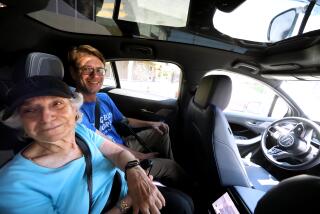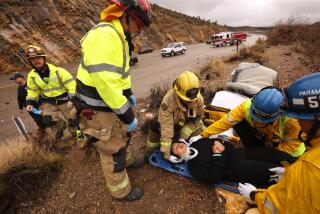Leery of Long-Distance Driving? Roll On, With Some Precautions
Two winters ago, I took a scenic drive to Death Valley. I lived in New York at the time, didn’t own a car and drove only when I was traveling to research a story. I knew how to change a tire in theory, fill the gas tank and open the hood, though what lay underneath was a greasy mystery to me.
The sun was shining when I left LAX in an economy-class rental car. I had good maps and assurance from the California Department of Transportation information hotline that the routes I had chosen, California 14 and U.S. 395 north to Lone Pine and California Highways 136 and 190 over 4,950-foot Towne Pass to Death Valley, were clear.
The trip turned tense when I discovered a slow leak in one of the tires, then hit snow on lonely, winding Highway 190. Fortunately, the roads in Death Valley were clear. Coming out of the valley three days later on California 127 was a nightmare that involved driving three hours in the dark through a rainstorm. Flash-flood signs scared me so badly that I was afraid to pull over. I was a wreck when I finally reached Interstate 15 at Baker.
Before this trip, I’d had lots of close calls traveling alone by car. Moreover, I’m aware that women behind the wheel make easy marks for robbers and carjackers and that mechanical ignorance can get us into trouble. So I should have known better.
I should have taken a cellular phone, says Holly Johnson, who has worked for the Automobile Club of Southern California for 18 years helping people plan trips.
“They are absolutely worth the expense,” Johnson says of cell phones. Just remember to pull off the road when using them.
She also advises women to map out an alternate route before starting a trip (in case of road closures) and to keep the doors locked and the gas tank full. Maps and guidebooks--signs that you aren’t local--shouldn’t be left in the open.
Women who are especially nervous about driving long distances alone can take more extreme precautions. “The Worst-Case Scenario Survival Handbook,” by Joshua Piven and David Borgenicht (Chronicle Books, $14.95), teaches skills most drivers hope they’ll never need, such as how to jump from a moving car. The Safety Zone, a New Jersey-based company, makes reception extenders for cell phones, portable battery rechargers and digital compasses (though it has discontinued Safe-T-Man, an inflatable male travel companion intended to make criminals think you’re not alone).
Sheila Swan, coauthor of “Safety and Security for Women Who Travel” (Travelers’ Tales Guides, $12.95), suggests tucking your hair into a fedora in dicey driving situations so you’ll look like a man.
Mechanical problems are a concern as well, one over which you may have little control. It pays to ensure your vehicle is in top condition before a trip and to learn a little about how it works, says Mary Jackson, author of “Car Smarts” (John Muir Publications, $17.95). Jackson, who started working as a mechanic in an auto body shop to support her skiing habit in Stowe, Vt., advises women to have the car’s oil changed and to get the fluids, tires and battery checked before departure. She also says women should travel with an emergency road kit that includes, among other things, a flashlight and jumper cables. She prefers to carry a full spare instead of an emergency tire (which often can’t be driven on for more than 100 miles).
Brushing up on your driving skills can’t hurt, says Bruce MacInnes, a senior instructor at the Skip Barber Racing School in Monterey. At one- and two-day clinics on accident avoidance ($550 for one day, $1,075 for two), he teaches students how to drive safely on highways, control a skid and use anti-lock brakes effectively. MacInnes thinks calm women make ideal race car drivers because their peripheral vision is wider than men’s, but he also cites a NASA study that found that women’s peripheral vision narrows more dramatically than men’s in stressful situations. That’s something to be aware of when you face danger on the road.
Driving a rental car in a foreign country also can be stressful, especially if you’re in a place where you’re driving on the left side of the road. I lost a side mirror on a narrow lane in England and had a fender bender in Jamaica because I didn’t give myself time to get used to left-side driving.
If you’re driving a rental car, adjust the seat position and mirrors and figure out how to operate lights and windshield wipers before you leave the lot, says former mechanic Jackson.
As an added precaution, my friend Margaret Fleetwood always rents a car just like her own.
The numerous driving hazards we face on the road shouldn’t be a deterrent, says Cameron Tuttle, author of “The Bad Girl’s Guide to the Open Road” (Chronicle Books, $14.95). “Road trips are the ultimate brain cleanser,” she says. When Tuttle hits the road, she always takes duct tape for repairing everything from engine hoses to bra straps; water; a sense of humor; and beef jerky, because, she says, it puts her in a road trip state of mind. I doubt she’d have much use for Safe-T-Man.
The Automobile Club of Southern California, telephone (877) 222-1020 (for members), Internet https://www.aaa-calif.com, for emergency roadside assistance and weather information.
California Department of Transportation Highway Information, tel. (800) 427-7623, Internet https:// www.dot.ca.gov/hq/roadinfo.
Safety Zone, tel. (800) 999-3030, Internet https://safetyzone.com.
Skip Barber Racing School, tel. (800) 221-1131, Internet https:// www.skipbarber.com.
More to Read
Sign up for The Wild
We’ll help you find the best places to hike, bike and run, as well as the perfect silent spots for meditation and yoga.
You may occasionally receive promotional content from the Los Angeles Times.






